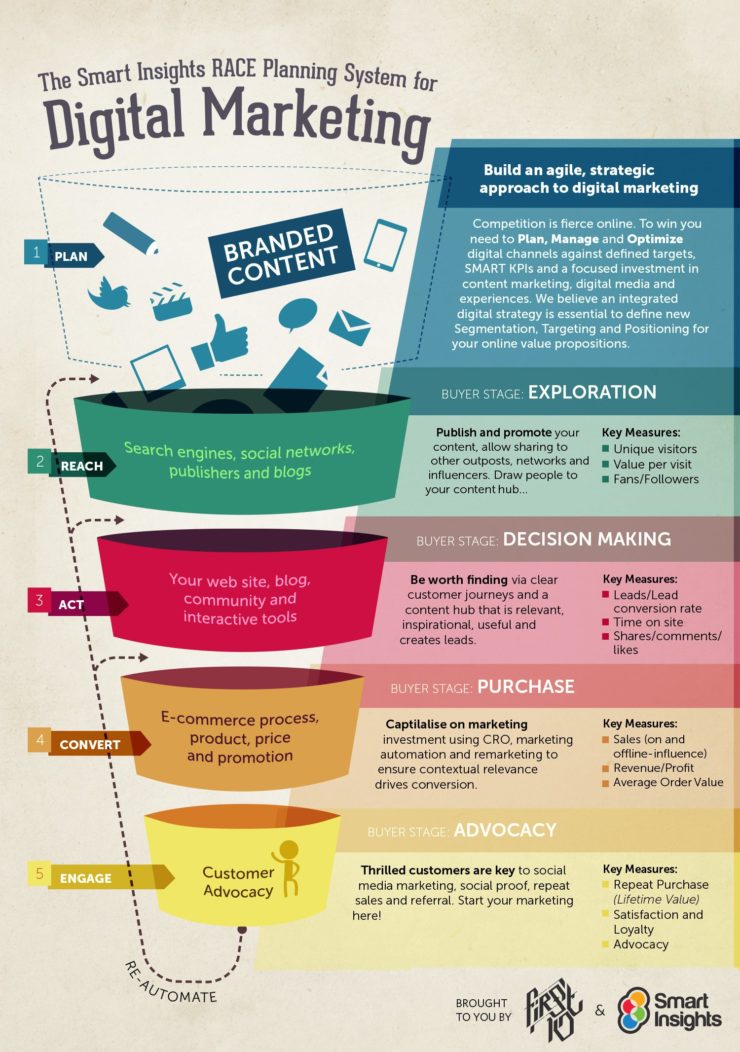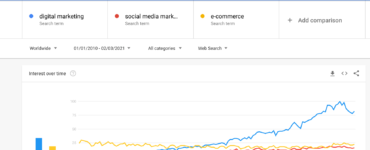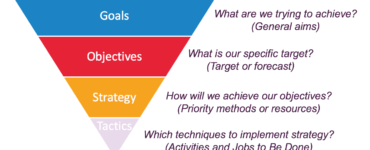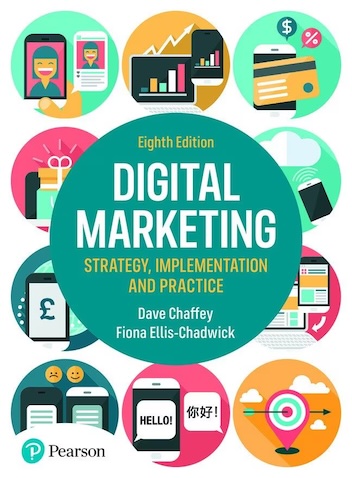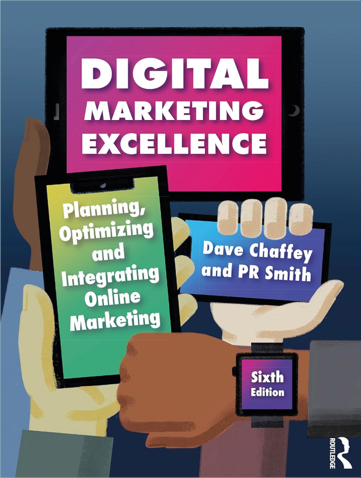Research from Smart Insights shows that many businesses still don’t have a defined digital marketing strategy, despite everyone doing digital marketing. The research also shows that many of those without a plan are looking to improve their competitiveness online, so 31% are aiming to launch a digital transformation project.
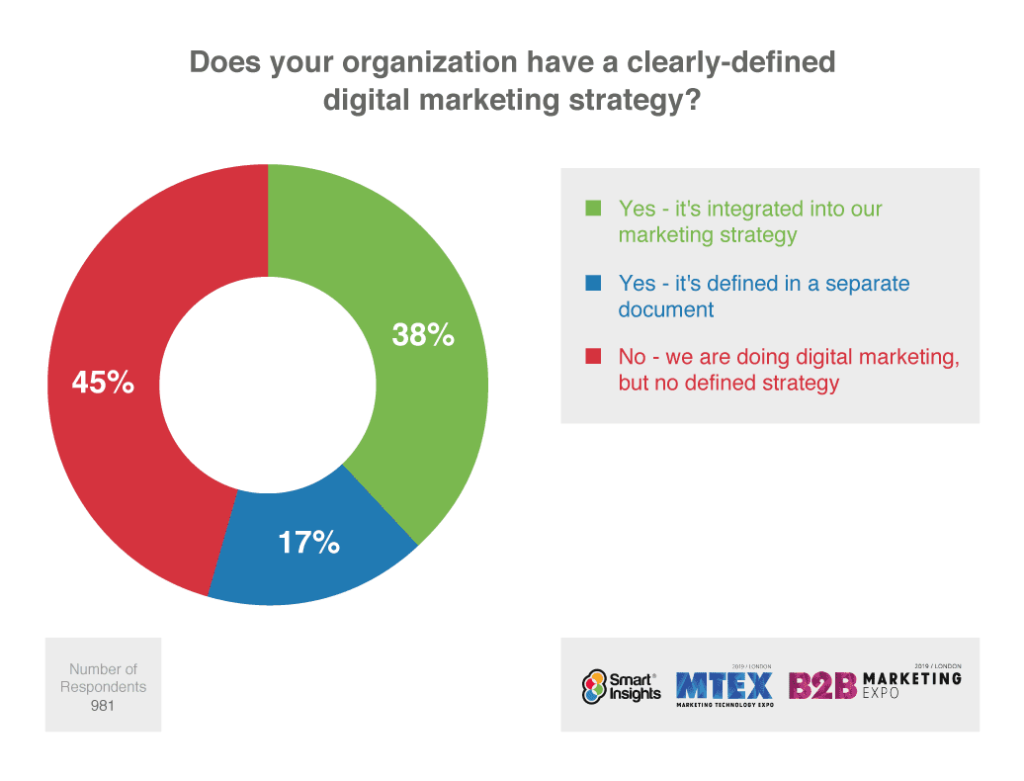
Why aren’t more businesses actively planning? Perhaps one reason for the lack of strategic digital plans is that digital marketing is complex and it can be difficult to know where to start. So, in this post, I’ll outline the potential ingredients of a solid digital plan based on my experience of working with many businesses of all types and sizes to structure digital plans. You’ll see there are many things to get right, which perhaps explains why it’s surprisingly common to not have a plan.
If you already have a plan, use this article as a checklist to see how yours compares, since a digital plan shouldn’t be a static document, but should be updated as your digital maturity improves and new opportunities become available.
1. Defines a process for plan creation and roll-out. To make your plan have an impact it needs to include both strategy, tactics and actions to implement. PR Smith’s SOSTAC® model provides a popular process framework, particularly for larger business. For smaller businesses and shorter plans, my preference is a simpler process framework that that we will use here to group the recommendations of the elements of a perfect plan, that’s Opportunity > Strategy > Action. I recommend you structure the digital marketing activities you need to work on in the Smart Insights RACE digital marketing planning framework.
If you think there are a scary number of activities here, remember many of these ingredients are needed to inform the strategy and schedule actions to implement it. If you’re short on time, ultimately your strategy can be a single page defining your objectives, a strategy to achieve them and how you will measure whether you are on track.
Define your opportunity
2. Set SMART objectives. To ensure your plan makes a difference to the future growth of the business, it’s important that it’s not limited to lofty, general aspirations. Instead it should be informed by a conversion model showing the value which will be generated.
3. Review current performance and business contribution from digital channels. In my experience, you can’t set objectives without looking at how digital is measured and reported on using Google Analytics or similar. Often, Google Analytics hasn’t been customized for a business, particularly where it is a non-transactional business like B2B. We’ll return to this in the Action section.
4. Objectives informed by audience and marketplace insights. You have your own insight collected about your online audience and competitors. Plus there are lots of great free resources from the major platforms like Facebook, Google and LinkedIn showing the demand for products in different markets based on search intent or the amount of interest in different services.
5. Share your digital vision. Larger organizations with transformation projects should define a vision, so you should paint a picture of the future organization that will help take others in the business with you.
6. Review the digital maturity of the organization. Scoring the business on its digital readiness, i.e. how well it competes on digital is useful both for identifying strategic initiatives that are needed, but also for making the case to stakeholders of how much the business needs to change and the investment needed.
7. Review employees digital skills. Re-skilling to compete with digital marketing will be needed in all businesses since digital skills change so fast and digital specialists may need to develop more general marketing communications skills. As part of situation review you can review the changes needed.
8. Benchmark relative to competitors. Another way of identifying initiatives and showing the changes needed and making the case for change is to show where your competitors are at, especially when they are ahead. Remember these shouldn’t be limited to direct competitors, but also competitors for attention, i.e. publishers and bloggers who are looking to engage similar audiences with their content.
Set your Strategy
9. Create a long-term roadmap. It’s likely that the strategic initiatives you develop as part of your digital strategy won’t be achieved within 6 months or even a year. Although there will be ‘quick wins’, your business will need to invest in new media and technology, create new processes and structures and develop the skills to support them. This won’t happen overnight, so your digital transformation roadmap will need to cover a 2 or 3-year lookahead and integrate with longer-term business plans.
10. Integrated with business and marketing plans. It’s essential that your digital plans align with your wider goals for the business. So show how digital initiatives align with the business.
11. Review new business model options. Often, digital marketing strategy is restricted to communications plans and the opportunity for impacting business or marketing plans aren’t considered. While they won’t be relevant in all cases, you should consider how digital communications give options for new product development or new targeting options to reach new types of audiences in different ways.
12. Includes acquisition and retention activities. There is a tendency for communications strategies to focus on how to win new customers and business. Digital strategies can ‘fall foul’ of this limitation too, so ideally, they should consider using digital communications for retention and advocacy. The website, email marketing and social media are all important here and have a role to play in advocacy and amplification to gain new customers too. The digital strategy should explain how you will review digital loyalty drivers and automate personalized messaging via the site and email to meet your retention goals.
13. Define Segmentation and Targeting techniques. STP or Segmentation, Targeting and Positioning are at the heart of marketing strategy. Similarly, they should have a starring role in Digital Strategy. This is because digital media give so many new options to use targeting to recruit and nurture prospects more closely. I recommend summarizing a ‘layered targeting strategy’ as part of your strategy including personas, profile, behavioural and interest-based targeting. Dynamic content can then be used within ads, on-site, messaging and in-app personalization to deliver more relevant, more contextual communications. But only if you plan it. The Martech supports this, but you have to define your targeting strategy.
14. Updated brand positioning including your digital value proposition (DVP). Existing businesses will typically have a brand story and brand messaging in place. Digital brings new ways to bring it to life, for example through video and social media sharing. Developing refined tone-of-voice and style guidance for online channels like web and social media is part of this.
15. Digital value proposition (DVP) and user experience. In my books, dating way back to 2000, I recommended business review their ‘OVP’ or Online Value Proposition as part of strategy. Clearly a website needs to communicate the core brand offering, but digital gives great opportunities to add value to an audience and so develop brand preference and support purchase intent. Today, a DVP or digital value proposition has a wider scope and can also be delivered via mobile apps, social media updates, email messaging or even virtual reality, augmented reality and Artificial Intelligence. For example, the bank ING uses AI to alert it’s customers to their spending patterns and when they have a risk of becoming overdrawn. The quality of digital experience becomes crucial since if competitors provide a better experience, it’s inevitable you will lose business, so auditing and continuously improving the quality of experience is essential.
16. Content marketing strategy. The content you offer via your different digital platforms is a big part of DVP and experience too. So auditing content quality and how it can be improved to better support marketing objectives is often a key digital strategic initiative. Content also has a wider role since it fuels customer acquisition, conversion and retention, for example through content developed and distributed through organic and paid search, social and email marketing. Given the explosion in content we have witnessed, getting cut-through compared to competitors and creating stellar content needs to be the goal. ‘Me too’ content won’t cut it. Content marketing strategy also includes content distribution and a key technique here is influencer relationship management (IRM), which many businesses aren’t familiar with, so this is another strategic digital initiative to consider.
17. Communications and engagement strategy for ‘always-on’ marketing. One of the key differences that digital marketing has brought compared to traditional marketing is that communications can be automated through the customer lifecycle. Customer are continuously searching for products and services so automation can be used to nurture them towards initial and subsequent sales. One of the biggest digital failings of many businesses is that they haven’t put in sufficient time to plan and optimize their ‘always-on’ activities which include site landing pages, nurture and re-engagement email communications, personalized website communications and retargeting using paid media.
18. New integrated campaign planning processes. That said, there is still a role for campaign communications to launch new products, run seasonal promotions and brand-led campaigns. These too give opportunities to use similar automated techniques to always-on communications, but campaign briefing, planning and editorial processes need to be updated to incorporate these too.
19. Marketing technology and insight. To implement the strategy will require investment in new ‘martech’ which today are typically cloud services. There are big decisions to be made here about selecting ‘best of breed’ specialist solutions versus broader marketing cloud services and how these are managed. Managing audience and marketplace insight is closely related since data integration between separate solutions is rated as a major challenge by most.
20. Brand governance. This may include new planning processes or new controls on communications such as privacy reviews for digital data security, social media employee use policies and digital crisis response plans as part of public relations. In the action section we describe changes to budgeting processes and the development of internal resources that accompany digital transformation.
Plan your actions
21. 90-day action planning. From the techniques we’ve covered, it’s likely your strategy and roadmap will contain many digital initiatives! Within each of these will be sub-activities which will need to be defined and implemented at a more granular level. We recommend 90-day action plans for each quarter which show the focus on different techniques across paid, owned and earned media and for improving the digital experience. For example, different AB tests can be scheduled each quarter for different parts of the customer journey to improve experience and conversion.
22. Identify the quick wins. You want to prove that your increased digital investment is delivering improvements, so prioritising quick wins within the 90-day plan will be a natural place to start with your 90-day plans which should also include setting the ground-work for longer-term plays.
23. Define dashboards and KPIs to review progression against target. In the ‘Opportunity’ section we mentioned that often analytics need to be customized to show specific goals for a business. Related to this is that work needs to be done outside Google Analytics to create dashboards to review performance against targets and corrective action, another aspect of 90-day action planning. I recommend using what I call the VQVC or Volume-Quality-Value-Cost metrics in dashboards since I find that often dashboards are limited to Volume metrics. To create business dashboards, data from different insight sources can be extracted using APIs to create dashboards as explained in this article.
24. REACH improvements. I recommend structuring the different strategic initiatives for your 90-day plans under the different parts of the Smart Insights RACE planning framework since includes a ‘Plan’ section covering governance activities. Your Reach initiative will covers critical success factors for the main channels and based on priortized improvements needed across organic and paid search, social media marketing, Online ads and influencer marketing.
25. ACT Improvements. These include improvements to the customer journey through site redesigns and AB testing for lead generation plus content quality and blog editorial planning improvements.
26. CONVERT improvements. Depending on the type of business these should include implementing and optimizing both online and offline touchpoints that lead to conversion to sale. These include nurture using email, push notifications and ad retargeting. Multichannel sales support through via phone sales and Livechat are also included.
27. ENGAGE improvements. The Engage part of RACE focuses on customer communications for retention and advocacy. Communications strategy are needed for all on-site and off-site automated messaging. Plus the digital customer experience including onboarding and customer service should be considered here.
28. Detailed budget. Once identified and prioritized, all activities across paid, owned and earned media needed to be budgeted for to include media costs, staff costs, marketing technology, data and agency or consultant input. Digital makes for complex budgets if you build them ‘bottom-up’, which you should.
29. Detailed resourcing plan. This will include internal re-skilling needed through training or acquiring new talent. Restructuring of teams may also be needed. It will also include review of the use of agencies to deliver against digital communications targets.
30. In-house skills development supported by Centres of Excellence. This is the path that larger organizations like Hilton have taken recently where they intend less dependency on agencies for key processes.
So, those my 30 recommended activities to inform your digital strategy.
I warned it was complex, but it can and should be simplified since it’s essential that the strategic initiatives are clear to others in your business. So make sure that as you build up the strategy you include a 1–2 page summary table of SMART objectives, agreed digital initiatives to achieve them and KPIs to make sure you are on track.
To help make the process more rapid, the Smart Insights Digital Marketing toolkit has Word, Excel and Powerpoint templates and examples I have created, so you don’t have to start with a blank page.
